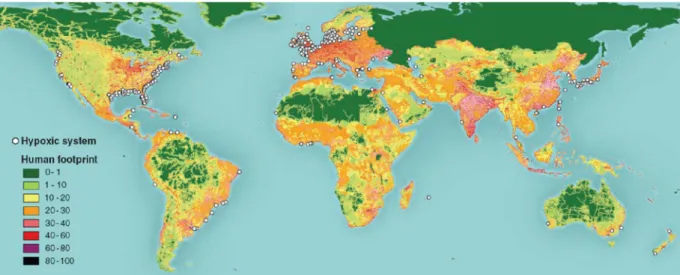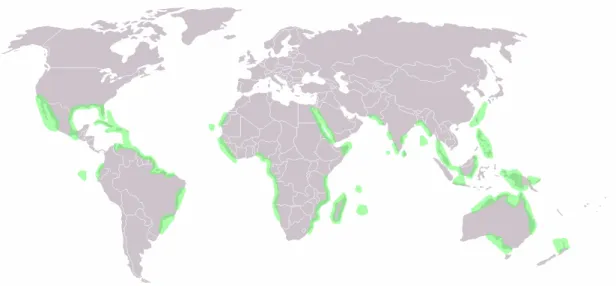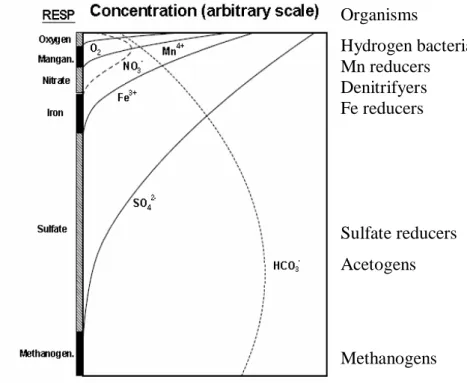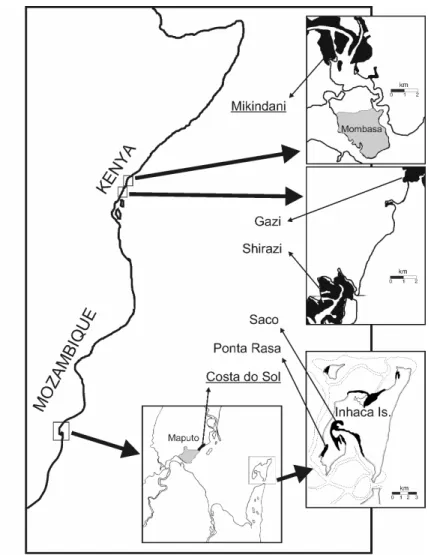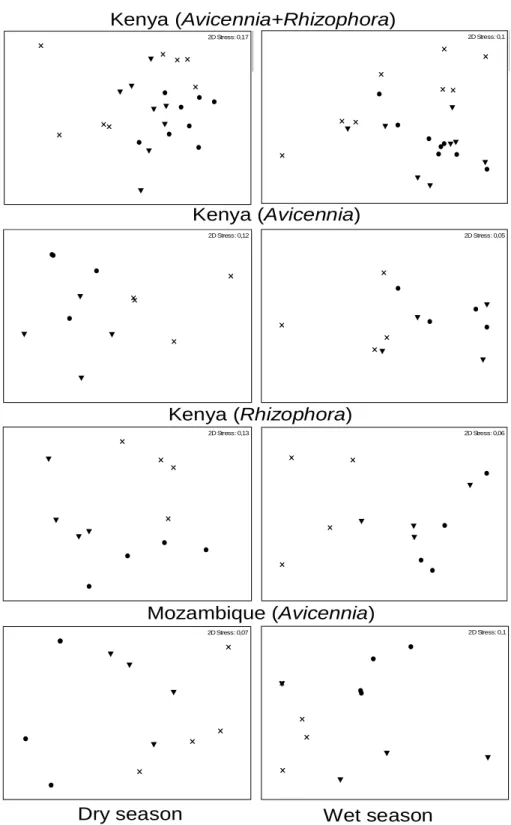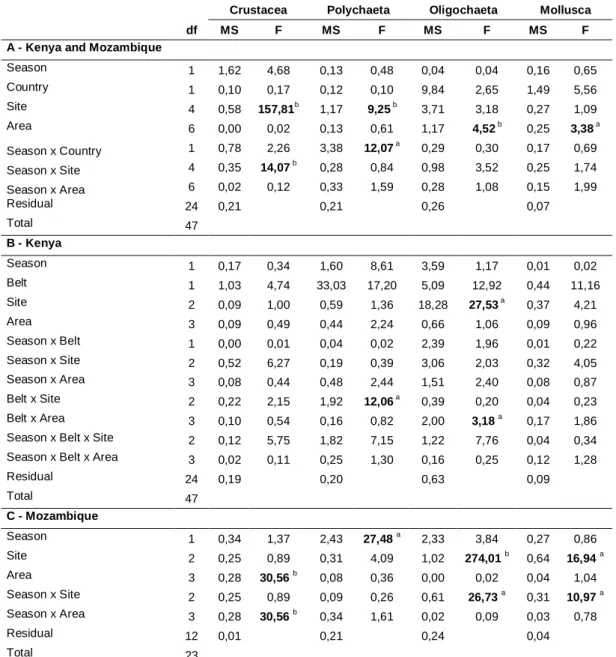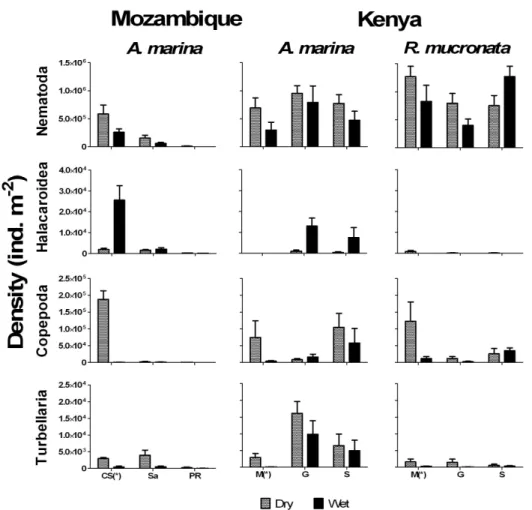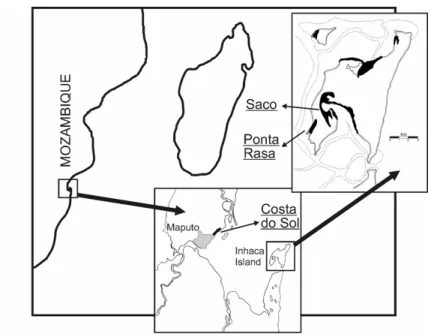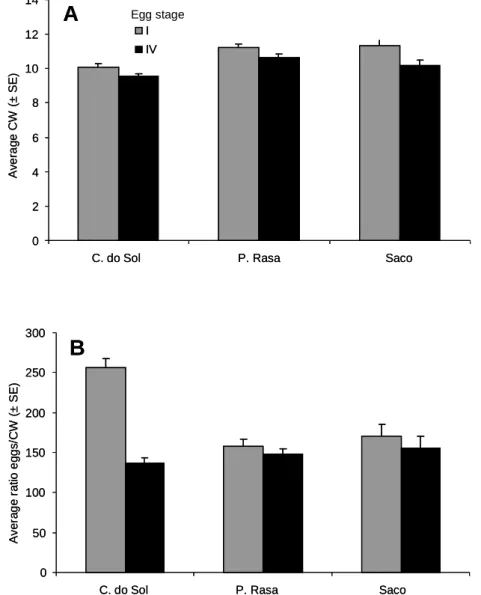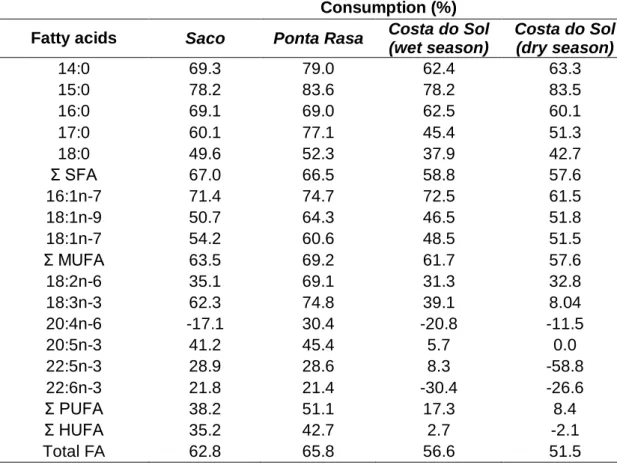Effects of domestic sewage on characteristics of mangrove communities and their functioning in East Africa
Gil Pessanha Penha-Lopes
Doutoramento em Biologia
Especialidade de Biologia Marinha e Aquacultura 2009
Fundação para a Ciência e a Tecnologia (FCT) through a PhD fellowship co-financed by Science and Innovation Operational Programme 2010 (POCI 2010) and European Social Fund (FSE) attributed to Gil Penha-Lopes (SFRH/BD/25277/2005)
Centro de Oceanografia, Laboratório Marítimo da Guia, Departamento de Biologia Animal, Faculty of Sciences of University of Lisbon
Department of Analytical and Environmental Chemistry, Vrije Universiteit Brussel, Brussels
Institute of Biology, University of Southern Denmark, Denmark
University of Dar es Salaam, Faculty of Aquatic Sciences and Technology, Dar es Salaam, Tanzania
Departamento de Ciências Biológicas, Faculdade de Ciências, Universidade Eduardo Mondlane, Moçambique
Kenya Marine and Fisheries Research Institute, Mombasa, Kenya
PUMPSEA project (Peri-urban mangrove forests as filters and potential phytoremediators of domestic sewage in east Africa), funded by the European Commission (No. FP6, INCO-CT2004- 510863)
__________________________________________________________________________ This dissertation should be cited as: Penha-Lopes (2009) Effects of domestic sewage on characteristics of mangrove communities and their functioning in East Africa. PhD Dissertation, University of Lisbon, Portugal
In accordance with Paragraph 1 of “Artigo 40, Capítulo V, do Regulamento de Estudos Pós-Graduados da Universidade de Lisboa, publicado no Diário da República – II Série No. 153, de 5 de Julho de 2003”, it is clarified that full scientific articles already published or in press (5), and submitted (4) for publication in peer-reviewed scientific journals, were used in the elaboration of this dissertation. Having such works been conducted in collaboration, the candidate acknowledges that he was fully involved in the planning, sampling, in all laboratory processes, data analysis and discussion of the results of all the works, as well as in their preparation and submission for publication, with the exception of the article "Behavioural responses of mangrove fiddler crabs (Uca spp.) to urban sewage loadings: results of a mesocosm approach", in which the candidate was not the leading author.
Acknowledgments/Agradecimentos ... xi
Abstract... xv
Resumo ... xvii
List of papers ...xxi
Section I General Introduction... 3
Opening remarks... 3
The PUMPSEA Project... 3
Anthropogenic pollution ... 4
Mangrove habitats... 5
Key mangrove fauna ... 7
Ecological indicators... 9
Mangrove macrofauna ecological indicators ... 12
Wastewater Wetlands ... 14
Mangrove potential as wastewater wetlands... 15
Ecosystem engineering ... 15
Organic matter degradation and microbial pathways ... 18
Aims and importance of this study... 21
Structure of the dissertation ... 22
References... 25
Section II Chapter 1 Effects of urban wastewater loading on macro and meioinfauna assemblages in equatorial and subtropical mangroves of East Africa ... 39
Chapter 2 Comparison of fecundity, embryo loss and fatty acid composition of mangrove crab species in sewage contaminated and pristine mangrove habitats in Mozambique ... 65
Chapter 3 Monitoring anthropogenic sewage pollution on mangrove creeks in sourthern Mozambique: a test of Palaemon concinnus Dana, 1852 (Palaemonoidae) as a biological indicator ... 87
wetlands? ... 111
Chapter 5 Behavioural responses of mangrove fiddler crabs (Uca spp.) to urban sewage loadings: results of a mesocosm approach ... 135
Chapter 6 Ecosystem engineering potential of the gastropod Terebralia palustris (Linnaeus, 1767) in mangrove wastewater wetlands - a controlled mesocosm experiment ... 157
Chapter 7 Population structure, density and food sources of Terebralia palustris (Potamididae: Gastropoda) in a low intertidal Avicennia marina mangrove stand (Inhaca Island, Mozambique)... 183
Chapter 8 Stable isotopes as indicators of sewage inputs and trophic changes in constructed mangrove wastewater wetlands... 205
Chapter 9 The role of biogenic structures on the biogeochemical functioning of mangrove constructed wetlands sediments – a mesocosm approach ... 225
SECTION III General Discussion ... 257
Ecosystem indicators... 257
The role of ecosystem engineering ... 261
Final Remarks... 263
Acknowledgments/Agradecimentos
Gostaria de agradecer a todas as pessoas que durante a minha Vida partilharam experiências ou conhecimento comigo e que me permitiram ser a pessoa que sou hoje. Dado me ser impossível (ou melhor impraticável) agradecer a todos vós, deixo aqui um abraço forte cheio de agradecimento e amizade. Vocês permitiram esta tese ser realizada com bastante dedicação, empenho, entusiasmo e espírito de partilha. Sei que por vezes não segui alguns conselhos e agradeço do fundo do coração todo o esforço de todos para viver com alegria todos os momentos da Vida, mesmo durante o doutoramento.
No entanto, várias pessoas contribuíram directamente para a realização desta tese e a elas gostaria de agradecer com particular destaque:
Ao Professor Doutor José Paula pela insistência de que teve para eu participar no projecto PUMPSEA como seu aluno de doutoramento. Este projecto permitiu-me crescer pessoal e profissionalmente por todas as viagens que realizei e lugares que conheci, pessoas que muito me ensinaram e vasto conhecimento e experiência que adquiri. Agradeço-lhe toda a orientação, ajuda, colaboração, apoio e disponibilidade que me disponibilizou mesmo antes de iniciar este doutoramento. Mais importante, agradeço especialmente a sua amizade e todos os bons momentos passados juntos, assim como as longas conversas sobre o rumo da ciência e vários projectos interessantes a realizar no futuro próximo.
To Professor Steven Bouillon for the opportunity to broad my horizons into the stable isotopes world as well as allow me to work at the Vrije Universiteit Brussels (VUB). Thank you for all the support, guidance and supervision even before accepting being my supervisor.
To Professor Erik Kristensen and Professor Mogens Flindt for co-supervise me while in Denmark and for welcoming me in Southern University of Denmark (SDU). Thank you for assuring all the necessary conditions for the work carried out in Denmark, for all the assistance, counselling, guidance, training and constant availability throughout these years. Thank you for all encouragement, long talks in Denmark as well as in the many countries in East Africa where we had the opportunity to work together, as well as live some really nice and/or thrilling moments. Hope some of them do not occur again, although all of them though us something. Thank you for your friendship and mainly your patience during the last months while writing this thesis.
À Fundação para a Ciência e Tecnologia pela concessão da bolsa de doutoramento que permitiu o desenvolvimento deste trabalho em vários países europeus e que culminou nesta dissertação e na publicação de vários artigos científicos gerados pela colaboração internacional, e pela cordialidade que sempre pautou a nossa relação.
To all co-authors of the manuscripts included in this work for their valuable contributions, suggestions and improvements to the manuscripts.
A todos os professores, colegas e amigos do Laboratório Marítimo da Guia, com quem tive a oportunidade de conviver durante os últimos anos. Obrigado por toda a ajuda durante o desenvolvimento dos meus trabalhos, pelo excelente ambiente de trabalho e companheirismo e pelos bons momentos passados juntos.
Agradeço em especial ao Paulo Torres por toda a sua amizade e apoio, assim como toda a ajuda, esforço e dedicação que despendeu em intensas amostragens, análises e discussões durante a escrita de vários artigos.
Também um forte agradecimento à Ana Pêgo, Inês Silva, Ricardo Mendes e Valter Amaral por estarem sempre disponíveis para me ajudar, por todo o conhecimento partilhado e pelos bons momentos passados juntos.
To all the professors, staff and students involved directly or indirectly in PUMSPEA project. Special thanks go for the people from the KMFRI, UEM, FAST, COeT, SDU, VUB, MUNIFI laboratories, institutions or universities that made possible the development of this work, for all their constant and valuable assistance. To all staff and students that, by one way or another, helped me to conduct the experiments and made my visits to East Africa, Belgium and Denmark a wonderful and learning experience.
I am particularly thankful to Perrine Mangion, Fabrizio Bartolini and Samwel Limbu for all the friendship, interesting discussions and good moments spent in the field, laboratory and office either in Africa or Europe. Thank you for your patient, excellent company and hospitality.
To Professor Stefano Cannicci for all the friendship, knowledge shared about life and science and for all the good moments spent in Tanzania and Kenya.
Special thanks go to Matthieu Delafosse, Katrina Povidisa, Yohana Santamaria, Cintia Quintana, Thomas
Valdemarsen
, for all the unforgettable good moments and friendship shared, and for the constant good mood, optimism and playful spirit during my stay in Denmark. Thank you for all the talks and for all your support and fruitful conversations about life and science.Ao Professor Doutor Luís Narciso por todo o apoio desde que fui seu estagiário e pela sua intensa curiosidade e entusiasmo que resultou numa extensa e interessante colaboração. Obrigado pelo seu constante optimismo e boa disposição e, especialmente, pelos muitos momentos divertidos passados em Portugal e em Moçambique.
À Doutora Judite Alves por me ter recebido no seu laboratório e disponibilizado o material necessário à análise de ácidos nucleícos.
A todos os meus amigos por todo o apoio, momentos inesquecíveis e conversas inspiradoras durante todo este período. Obrigado pela vossa amizade e por me mostrarem que me aceitam tal como sou.
À Helena Andrade, minha amiga ao longo destes últimos anos. Obrigado pelo incondicional apoio, incentivo e confiança e pela incansável tolerância para comigo, especialmente nos momentos menos bons. Também à sua família por me ter apoiado incondicionalmente durante todo este período e por terem acreditado em mim.
Gostaria de agradecer à minha família por todo o Amor que me deram durante toda a minha Vida. Agradeço especialmente aos meus pais, à Margarida, aos meus irmãos, e aos meus avós por todo o apoio e incentivo durante esta jornada para a concretização de um sonho. Foram também responsáveis pela pessoa que me tornei e para os quais gostaria de expressar a minha sincera gratidão. Obrigado por tudo.
Abstract
In the last 15 years, several studies investigated the effects of domestic contamination in mangrove ecosystems, however, only few have recognized mangrove fauna species as effective bioindicators and biomonitors of anthropogenic contamination. The present work intends to better understand the effect of high loadings of organic matter on fauna inhabiting natural mangrove ecosystems or mangrove mesocosms as well as their ecosystem functioning.
Our results demonstrated that identifying infauna organisms to high taxonomic levels may not be a reliable tool as most of the community changes must occur at a functional group level and consequently at genus and species levels. Although there was a decrease in their diversity indexes at the peri-urban mangrove sites, only Oligochaeta group has shown to be a potential reliable indicator. In peri-urban areas, the reproductive season of crustaceans was extended, the percentage of ovigerous female increased and reproductive potential and embryo quality improved. Nevertheless, negative indicators included high percent of shrimp parasitation in natural mangrove creeks as well as lower survival and growth rates of fiddler crabs and gastropods in constructed mangrove wetlands (CMW).
Most recent studies on mangrove sewage filtration have focussed on the role of trees and sediment with associated microbes and microalgae. In our study, we have found that key mangrove macrofauna decreased feeding activity, and consequently top sediment disturbance, although slightly increasing sediment turnover, through burrow construction and maintenance.
Carbon dioxide and methane production and carbon oxidation pathways were also evaluated at different sewage concentrations and vegetation conditions and in the absence or presence of biogenic structures. Our results clearly show impacts of sewage on the partitioning of electron acceptors in mangrove sediment and confirm the importance of biogenic structures for biogeochemical functioning, by increasing organic matter mineralization, and consequently CMW efficiency.
Keywords: Bioindicators, Biomonitors, Ecosystem engineering, Benthic fauna, Wastewater pollution, Mangroves, East Africa
Resumo
As florestas de mangal estão localizadas em zonas costeiras tropicais. Embora apresentem uma relevância ecológica global, tais como sumidouro de carbono e áreas de viveiro de peixes e crustáceos, os mangais fornecem igualmente alimentos, fibras, madeira, produtos químicos e medicamentos às populações humanas locais. No entanto, durante as últimas décadas, os ecossistemas costeiros foram sofrendo forte pressão antropogénica devido a actividades de desflorestação e despejo de contaminantes, levando a uma redução anual da sua área em 1-2%.
O rápido aumento da população, e consequente urbanização e industrialização em zonas costeiras, resultaram em graves problemas ambientais e socioeconómicos. No entanto, determinar quando contaminação resulta em poluição exige em particular a análise das comunidades biológicas. Desta forma, torna-se importante a identificação precoce de biomonitores e/ou bioindicadores específicos de contaminantes. Por outro lado, as alterações na estrutura da comunidade e em especial das suas actividades podem conduzir a profundas alterações da sua função no ecossistema, afectando significativamente a sua robustez e sustentabilidade. Nos últimos 15 anos, vários estudos debruçaram-se no efeito da contaminação doméstica em florestas de mangal e comunidades faunísticas associadas, no entanto, poucos têm reconhecido espécies de fauna como eficazes bioindicadores e biomonitores de contaminação antropogénica.
Estes sistemas mostraram recentemente um potencial para o tratamento de águas residuais, minimizando a poluição costeira. Estudos têm demonstrado que os sedimentos destes ecossistemas são muito eficientes na remoção de nutrientes sem aparentes impactos negativos sobre as árvores de mangal ou comunidades de invertebrados bentónicos. Estações de tratamento de esgoto utilizando plantas de mangal estão agora a ser instaladas e estudadas, principalmente devido ao seu baixo custo e alta eficiência, embora tenha já sido demonstrado que cargas de água residual acima da capacidade do sistema e fracas condições hidrodinâmicas levam geralmente à eutrofização do sistema, e consequentemente a condições de hipoxia ou anóxia. Nestas condições é esperada uma redução de diversidade e biomassa em sistemas naturais, assim como elevadas taxas de mortalidade em sistemas artificiais. Esta situação poderá alterar significativamente o funcionamento dos ecossistemas devido à redução da actividade das espécies com maior potencial de bioturbação do sedimento, afectando potencialmente a saúde e eficiência de filtração do sistema, quer natural quer artificial. Enquanto a maioria dos estudos concentrou-se sobre o potencial das plantas e sedimentos, incluindo micróbios e microalgas, na degradação da matéria orgânica
e filtração dos nutrientes, poucos têm estudado o potencial filtrador da macrofauna em locais peri-urbanos ou em sistemas artificiais sujeitos a elevadas concentrações de esgoto.
A secção I fornece uma breve descrição do projecto PUMPSEA, dos ecossistemas de mangal e comunidades faunísticas associadas. O efeito da poluição antropogénica em zonas costeiras tropicais (mangais) e a potencialidade destes sistemas para o tratamento de esgotos serão também brevemente descritos. Serão também ilustrados os processos da degradação da matéria orgânica assim como o papel da fauna (bioturbação) como um possível instrumento para aumentar o potencial filtrador destes sistemas.
A fim de cumprir os objectivos do presente estudo, nove estudos foram realizados resultando cada um em um manuscrito. Esta dissertação incorpora estes documentos, cada um constituindo um capítulo completo (Secção II), estando estes aceites ou publicados (5), submetidos (4) em revistas científicas internacionais.
No capítulo 1 do presente estudo, desenvolvem-se as possíveis diferenças na estrutura da comunidade da infauna em zonas de mangal peri-urbanas impactadas por esgotos doméstico e zonas não poluídas ao longo da África Oriental, utilizando análises multivariadas ou de diversidade básicas.
Pela primeira vez parâmetros reprodutivos de espécies de mangal foram avaliados como indicadores de contaminação de matéria orgânica e nutrientes. No capítulo 2 apresentam-se parâmetros reprodutivos, incluindo fecundidade, fertilidade e qualidade dos embriões (medido através da análise de ácidos gordos) de populações de caranguejo violinista, uma das espécies mais comuns em zonas de mangal, Uca annulipes (H. Milne Edwards, 1837), que habitam em locais peri-urbanos (contaminados) e mangais relativamente pristinos no sul de Moçambique.
Dado que a maioria dos contaminantes são descarregados para os canais dos mangais, um estudo multidisciplinar foi realizado nos mesmos locais que o estudo anterior utilizando populações de camarões residentes (Palaemon concinnus (Dana, 1852)). No capítulo 3, a estrutura populacional, parâmetros reprodutivos (como curvas de maturação, fecundidade, fertilidade e qualidade dos embriões), infecção parasitária e rácio de RNA / DNA foram usados como indicadores para testar a qualidade do habitat.
No capítulo 4, o efeito de diferentes condições do esgoto e vegetação na sobrevivência e bioturbação de caranguejos em unidades artificiais de mangal (mesocosmos) foi avaliada. O comportamento destas espécies de caranguejo foi também utilizado como um potencial indicador de contaminação de águas residuais (capítulo 5). O efeito da concentração de esgotos e presença de vegetação na sobrevivência, crescimento e comportamento da Terebralia palustris foi avaliado no capítulo 6. No mesmo capítulo, o papel
destes gastrópodes na dinâmica do sedimentos foi avaliada e as suas consequências na biogeoquímica do sedimento discutida. Sabendo que estes gastrópodes são capazes de se alimentar de uma grande variedade de fontes alimentares, no capítulo 7, a distribuição, o comportamento e as estratégias alimentares deste gastrópodes foram avaliadas no campo, a fim de melhor compreender o seu potencial nos sistemas artificiais de mangal com o objectivo de filtrar os esgotos domésticos.
No capítulo 8, que teve por objectivo estudar os efeitos dos esgotos domésticos nos isótopos estáveis de diferentes compartimentos das unidades de tratamento de esgotos (sedimento, microalgas bentónicas, árvores de mangal e fauna), os isótopos estáveis foram reconhecidos como bons indicadores de poluição antropogénica. O seu estudo permitiu também analisar a dieta das duas espécies de macrofauna estudadas (Uca annulipes e
Terebralia palustris) sob diferentes cargas de efluentes domésticos e vegetação, a fim de
compreender a importância destas espécies no funcionamento destas estações de tratamento.
O capítulo 9 incidiu sobre a emissão de dióxido de carbono e metano sob períodos de imersão e emersão, com especial ênfase na importância de estruturas biogénicas (como raízes aéreas e galerias de caranguejo), bem como nas vias de oxidação de carbono mais utilizadas em diferentes condições de esgoto e vegetação. Ambos os processos são importantes para compreender totalmente os efeitos de descargas de matéria orgânica sobre os ecossistemas de mangal assim como fornecer conhecimentos básicos para o desenvolvimento futuro de estações de tratamento de esgotos biológicas, utilizando como modelo os ecossistemas de mangal.
Os resultados mais significativos desta secção são também descritos. O presente estudo demonstrou que a identificação de organismos pertencentes à infauna a níveis taxonómicos elevado não pode ser um instrumento fiável como indicador de poluição doméstica, uma vez que as alterações são geralmente sentidas na alteração dos grupos funcionais, e consequentemente só podem ser reconhecidas ao nível do género ou espécie. Uma ligeira diminuição dos índices de diversidade e dos organismos pertencentes ao grupo Oligochaeta em locais peri-urbanos, poderão ser considerados como potenciais bioindicadores de contaminação antropogénica. Em zonas peri-urbanas, a época reprodutiva de crustáceos foi prolongada, tendo a percentagem de fêmeas ovígeras aumentado assim como o seu potencial reprodutivo e a qualidade dos embriões. No entanto, indicadores negativos incluíram elevados níveis de parasitismo de camarões em mangais peri-urbanos,
bem como reduzida taxa de sobrevivência e crescimento de caranguejos e gastrópodes nos sistemas artificias.
Neste estudo foi observada uma redução significativa da actividade alimentar de caranguejos e gastrópodes, diminuindo significativamente a quantidade de sedimento processado durante as actividades de alimentação, embora aumentando ligeiramente o volume de sedimento revolvido durante a construção e manutenção das galerias de caranguejo.
Os nossos resultados mostraram também claramente os impactos dos efluentes sobre as vias de oxidação de carbono no sedimento e confirmaram a importância das estruturas biogénicas na biogeoquímica e metabolismo do sedimento, e consequentemente na eficácia das estações de mangal para o tratamento de esgotos.
Uma discussão geral considerando todos os estudos realizados, as principais conclusões extraídas deste estudo e as contribuições feitas para aumentar o conhecimento de potenciais bioindicadores e biomonitores de esgoto doméstica utilizando a fauna de mangal, bem como as suas implicações no funcionamento do ecossistema em sistema contaminados artificiais são o conteúdo da Secção III. Nesta mesma secção será feita uma reflexão sobre as questões levantadas durante este estudo e propostas de estudos a realizar no futuro próximo.
Palavras-chave: Bioindicadores, Biomonitores, Bioturbação, Fauna bentónica, Esgoto, Mangais, África Oriental
List of papers
This dissertation comprises the following scientific manuscripts:
Penha-Lopes, G., Xavier, S., Okondo, J., Cannicci, S., Fondo, E.N., Ferreira, S., Macamo, C., Macia Jr, A., Mwangi, S., Paula, J., submitted. Effects of urban wastewater loading on macro and meioinfauna assemblages in equatorial and subtropical mangroves of East Africa. Western Indian Journal of Marine Science
Penha-Lopes, G., Torres, P., Narciso, L., Paula, J., accepted. Comparison of fecundity, embryo loss and fatty acid composition of mangrove crab species in sewage contaminated and pristine mangrove habitats in Mozambique. J. Exp. Mar. Biol. Ecol. Penha-Lopes, G., Torres, P., Cannicci, S., Narciso, L., Paula, J., submitted. Monitoring
anthropogenic sewage pollution on mangrove creeks in southern Mozambique: a test of Palaemon concinnus Dana, 1852 (Palaemonoidae) as a biological indicator. Environ. Pollut.
Penha-Lopes, G., Bartolini, F., Limbu, S., Cannicci, S., Paula, J., in press. Are fiddler crabs potentially useful ecosystem engineers in mangrove wastewater wetlands? Mar. Pollut. Bull.
Bartolini, F., Penha-Lopes, G., Limbu, S., Paula, J., Cannicci, S., in press. Behavioural responses of mangrove fiddler crabs (Uca spp.) to urban sewage loadings: results of a mesocosm approach. Mar. Pollut. Bull.
Penha-Lopes, G., Bartolini, F., Limbu, S., Cannicci, S., Mgaya, Y., Paula, J., in press. Ecosystem engineering potential of the gastropod Terebralia palustris (Linnaeus, 1767) in mangrove wastewater wetlands - a controlled mesocosm experiment. Environmental Pollution Series A, Ecological and Biological
Penha-Lopes, G., Bouillon, S., Mangion, P., Macia Jr, A., Paula, J., in press. Population structure, density and food sources of Terebralia palustris (Potamididae: Gastropoda) in a low intertidal Avicennia marina mangrove stand (Mozambique). Estuar. Coast. Shelf Sci., doi:10.1016/j.ecss.2009.1004.1022
Penha-Lopes, G., Mangion, P., Limbu, S., Kristensen, E., Dehairs, F., Bouillon, S., Paula, J., submitted. Stable Isotopes as indicators of sewage and trophic changes in constructed mangrove wastewater wetlands. Mar. Pollut. Bull.
Penha-Lopes, G., Kristensen, E., Flindt, M., Mangion, P., Bouillon, S., Paula, J., submitted. The role of biogenic structures on the biogeochemical functioning of mangrove constructed wetlands sediments – a mesocosm approach. Environ. Pollut.
General Introduction
Opening remarks
Ecological damage due to anthropogenic activities is threatening marine eco-systems and coastal resources around the world. Growing population, increasing urbanisation and rapid industrialisation have resulted in serious environmental and socio-economic crises in coastal cities (Sharma, 2000; Mohammed, 2002a; Diaz and Rosenberg, 2008). However, determining when contamination results in pollution requires not only chemical but also biological measurements (Chapman, 2007). Some of these contaminants are known to cause the destruction of entire coastal shallow-water communities, affecting animal physiological functioning, behaviour, reproductive success, and outright mortality in associated invertebrates and fishes (Peters et al., 1997; Kennish, 2002). This way it becomes important to identify early bioindicators or biomonitors of contaminants in natural conditions. On the other hand, changes in community structure or in species behaviour and activities may lead to changes in the ecological role of fauna, which may affect significantly ecosystems health and sustainability.
The following section of this introduction provides a brief description of the project PUMPSEA and an overview of anthropogenic pollution in coastal zones, mainly in tropical regions, mangrove ecosystems and their associated fauna communities and early warning indicators of pollution used globally and in mangrove forest. Furthermore, the role of wastewater wetlands and the potential of mangroves to treat sewage are also briefly described. The organic matter degradation and nutrient cycling processes will also be illustrated and the ecosystem engineering role of fauna as a potential tool to increase these processes will also be clarified. Finally, the aims and objectives of this study are outlined, and the rationale driving to the investigations conducted is explained.
PUMPSEA project
This PhD thesis was done within the PUMPSEA (Peri-urban mangrove forests as filters and potential phytoremediators of domestic sewage in east Africa) project that was built based on the preliminary observation and studies that mangroves filtrate discharged wastewater and prevent coastal pollution, although this ecosystem service has not been conveyed to coastal management, nor has the filtration capacity been fully exploited. In this light, the overall objective of this project was to demonstrate the ecological and economical service that peri-urban mangroves provide by mitigating coastal pollution through
sewage-filtration, and to offer innovative solutions for the exploitation and management of this service. The project examined two innovative ways in which mangrove filtration can be utilised to preclude coastal sewage pollution: (1) facilitating sewage filtration by conserving filtering mangroves and replanting mangroves in deforested areas exposed to sewage (´strategic reforestation and conservation'), and (2) using constructed mangrove wetlands for sewage treatment. It also developed an implementation plan for the exploitation of the developed technology and know-how, based on analysis of governance, policy, cost and financing options. At the same time, several studies tried to better understand the impact of sewage contamination on ecosystem health and processes, including microbial, fauna and flora diversity and abundance as well as sediment biogeochemical processes. This work took place in peri-urban mangrove areas of Maputo (Mozambique), Dar es Salaam (Tanzania) and Mombasa (Kenya) and pristine (control) mangrove areas nearby, and involved several African and European scientific teams and expertise fields.
Anthropogenic pollution
In peri-urban areas, wastewater loadings rich in labile organic matter and nutrients are common and under weak hydrodynamic conditions usually lead to eutrophication. Accumulation of particulate organic matter will encourage microbial activity and the consumption of dissolved oxygen in bottom waters leads to hypoxic or even anoxic conditions (Gray et al., 2002; Diaz and Rosenberg, 2008). The worldwide distribution of coastal oxygen depletion is associated with major population centers and watersheds that deliver large quantities of nutrients (Figure 1). Low oxygen levels, and consequently production of toxic components (such as sulphite and ammonia) may decrease faunal diversity and biomass due to emigration of mobile species or high mortality of less mobile species in natural ecosystems (Diaz and Rosenberg, 1995). This could also significantly affect ecosystem functioning (Biles et al., 2002; Le Hir et al., 2007), and coupled with a potential decrease in activity and behaviour of the more resistant species (Diaz and Rosenberg, 1995) potentially reduce the ecosystem health and functioning.
In tropical developing countries the lack of technical solutions for sewage treatment, combined with an increase in population growth and migration to coastal areas, has lead to a rapid increase in urban wastewater production, which is putting breakpoint pressures on already inadequate sewage systems (e.g., Mohammed, 2002b).
Figure 1 – Global distribution of 400-plus systems that have scientifically reported accounts of being eutrophication-associated dead zones. Their distribution matches the global human footprint in the northern hemisphere, while for the Southern hemisphere, the occurrence of dead zones is only recently being reported. (adapted from Diaz and Rosenberg, 2008)
As a result, peri-urban coastal areas receive extensive amounts of untreated sewage, which is typically discharged into creeks lined by mangrove forests. Although this uncontrolled drainage of raw sewage into peri-urban coastal areas is a factual result, there is hardly any understanding of its consequences regarding ecosystem health (Holguin et al., 2001; Adeel and Pomeroy, 2002).
Mangrove habitats
Mangroves can be defined as trees and shrubs that grow in saline (brackish) coastal habitats in the tropics and subtropics (see Figure 2), where water temperature does not go below 20ºC. The word is used also more broadly to refer to the habitat and entire plant assemblage, for which the terms mangrove swamp and mangrove forest are also used. Mangrove areas are characterized by multiple substrate conditions but usually fine sediments, often with high organic content, low energy wave action, freshwater runoff, prolonged hydroperiod, salinity, anoxic conditions, and accumulation of toxic substances (Hogarth, 2007). Species composition is strongly influenced by these coastal settings because they are linked to differences in mangrove tree species’ capability to become established and grow. True mangroves comprise some 55 species in 20 genera, belonging to 16 families, although the Avicenniaceae and Rhizophoraceae comprise most of the species (Hogarth, 2007; Ellison, 2008).
Figure 2 – World Distribution Map of Mangroves.
These ecosystems accomplish a number of functions and services (Duke et al., 2007). These forests are one of the most productive systems (> 2 t ha-1 yr -1), and as a result they play a key role in nutrient cycling of coastal zones and global carbon cycling, and showed to act both as source and sink areas (Kristensen et al., 2008; Alongi, 2009). Its structure and productivity are crucial components of estuarine habitats that support ecosystem services such as nursery areas for fish, prawns and crabs (Sheridan and Hays, 2003; Crona and Rönnbäck, 2005). Human communities living near mangroves also rely on the provision of a variety of food, timber, chemicals and medicines derived from mangrove forests or associated plants (Ewel et al., 1998; Glaser, 2003; Stone, 2006). After the 2004 tsunami, mangrove forests proved also their effectiveness in protecting coastlines (Dahdouh-Guebas et al., 2005; Kathiresan and Rajendran, 2005).
Despite the great social, economic, and environmental importance of mangroves in tropical ecosystems (Rönback et al., 2007; Nagelkerken et al., 2008; Walters et al., 2008), during the last decades, mangrove ecosystem have been reduced at a rate of 1-2% due to anthropogenic influence through deforestation and dumping activities (Duke et al., 2007; Kruitwagen et al., 2008). Also, environmental monitoring and assessment of these systems are still lacking (Peters et al., 1997). Most studies done in these forests have pursued the quantification in situ (water, sediment samples as well as in organisms) of anthropogenic contaminants such as heavy metals, organotins, organochlorine pesticides and polychlorinated biphenyls, among others (Uma Devi and Prabhakara Rao, 1989a; b; De Wolf et al., 2001; Mohammed, 2002b; Kruitwagen et al., 2008), while the classification of pollution using key fauna communities or species as bioindicators has been neglected.
Key mangrove fauna
Mangrove ecosystems harvest a unique set of associated faunal species (Vannini et al., 2002; Lee, 2008). A unique and diverse assemblage of benthic invertebrates, including gastropods, polychaetes, oligochaetes and burrowing brachyuran crabs, such as sesarmids and fiddler crabs, are considered the most important functional groups in this ecosystem (Cannicci et al., 2008). This is mainly due to their high biomass, significantly affecting vegetation structure by leaf consuming and propagule predation, regulation of benthic microalgae biomass and productivity, sediment properties, mainly through their ecosystem engineering activities, and controlling energy flow between mangroves and nearby ecosystems (Cannicci et al., 2008; Kristensen et al., 2008).
Gastropods
Gastropods play an important ecological role in natural systems through organic matter consumption (Slim et al., 1997; Fratini et al., 2004), bioturbation effects on nutrient cycling (Biles et al., 2002), regulation of meiofauna and microphytobenthos biomass (Carlén and Ólafsson, 2002; Pape et al., 2008), changes in the dynamics of suspended material (Kamimura and Tsuchiya, 2004) and effects on sediment stability (Orvain et al., 2003; 2004; 2006). In mangrove forests more than 30 species of gastropods can be found (Hogarth, 2007), and total densities can achieve values higher than 200 m-2 (Houbrik, 1991).
The mudwhelk gastropod Terebralia palustris (Linnaeus, 1767) is a key epifaunal species in mangrove forests around the world (Soemodihardjo and Kastoro, 1977; Nishihira, 1983; Houbrik, 1991; Slim et al., 1997; Dahdouh-Guebas et al., 1998; Fratini et al., 2004; Pape et al., 2008). Studies have shown that it is important for the nutrient cycling by consuming large amounts of Avicennia marina (Forsk.) and Rhizophora mucronata Lam. litter, mangrove propagules, carrion, detritus, benthic diatoms and bacteria (Nishihira, 1983; Rambabu et al., 1987; Dahdouh-Guebas et al., 1998; Fratini et al., 2000; Fratini et al., 2004). It can also regulate microphytobenthic primary productivity and meiobenthos community through feeding and/or crawling activities (Schrijvers et al., 1996; Schrijvers et al., 1998; Carlén and Ólafsson, 2002; Pape et al., 2008). This intertidal snail seems able to discriminate between different food items and can potentially use both air-borne and water-borne odours to locate food (Fratini et al., 2001; Fratini et al., 2008). A spatial separation between young and older individuals was first observed by Soemodihardjo and Kastoro (1977). Due to anatomical differences in the structure of the radula, only large (shell height >5 cm) T.
palustris actively feed on fallen mangrove leaves, propagules and fruits, while small
Houbrik, 1991; Slim et al., 1997; Dahdouh-Guebas et al., 1998; Fratini et al., 2004; Pape et al., 2008).
Crabs
Brachyuran crabs, primarily fiddler crabs (family Ocypodidae) and leaf-eating sesarmid crabs (family Grapsidae), dominate the mangrove fauna in number and biomass (Kristensen, 2008), and these burrowing decapods are key components of Indo-Pacific mangroves (Lee, 1998).
More than 97 species of fiddler crabs (genus Uca), although not all present in mangrove ecosystems, establish dense populations reaching more than 150 individuals m-2 on intertidal flats (Rosenberg, 2001; Skov and Hartnoll, 2001; Skov et al., 2002; Cannicci et al., in press), making them important grazers on microalgae and bacteria (Bouillon et al., 2002; Reinsel, 2004). As many as 36 species of sesarmid crabs have been found in mangrove forests of Thailand (see references in Thongtham et al., 2008) and densities are much lower than for fiddler crabs, reaching average values of 6 m-2 (Cannicci et al., in press) and mainly consuming organic matter, dead fauna and leaves (Thongtham and Kristensen, 2005; Cannicci et al., 2008; Lee, 2008; Thongtham et al., 2008).
Fiddler crabs of genus Uca (Ocypodidae) are characterised by strong sexual dimorphism and male asymmetry and are a well known group due to the fact that one of the male chelae is very enlarged and carried horizontally across the front, like a fiddle. This bigger chelae is used for protection, aggressive and female courtship behaviours (Eshky et al., 1995). Fiddler crabs are known to inhabit and seal their burrows during immersion periods (De la Iglesia et al., 1994), while feeding, waving (as a female courtship behaviour), and gallery maintenance activity during emersion period during day time (Eshky et al., 1995). These crabs have been the subject of a wide variety of studies, including taxonomic (Crane, 1975; Rosenberg, 2001), reproductive parameters and behaviour (e.g., Hyatt, 1977; Christy, 1982; Backwell and Passmore, 1996; Backwell et al., 1999; Litulo, 2004a; c; b; 2005d; c; b; 2006; Torres et al., 2008; 2009), visual and acoustic display (Salmon, 1965; Salmon and Atsaides, 1968; Cannicci et al., 1999), morphometric relations and dynamics (e.g., Huxley, 1924; Huxley and Callow, 1933; Levinton and Judge, 1993; Takeda and Murai, 1993), aggressive, foraging and burrowing behaviour (Murai et al., 1982; Weissburg, 1992; Wolfrath, 1992; Weis and Weis, 2004) and a few studies on toxicity, environmental monitoring and pollution (e.g., Devi, 1987; Weis and Kim, 1988; Ismail et al., 1991; Das and Chakraborty, 2004; Mokhtari et al., 2008).
Infauna
Diversity and abundance studies of infauna in Indo-Pacific mangrove forests are still scarce (Sasekumar, 1974; Guerreiro et al., 1996; Fondo and Martens, 1998; Metcalfe and Glasby, 2008) mainly due to limited taxonomic expertise or resources availability in developing countries (Thorne and Williams, 1997). Polychaeta species represent more than 90% of the biomass of macroinfauna and more than 60 species were already observed in Australian mangroves (Metcalfe and Glasby, 2008). Regarding meiofauna, total densities can easily reach 2.46 x 106 m-2 and nematods are usually the most abundant group representing more than 80% of the total density (Dye, 1983; Ólafsson, 1995) and more than 90 genera belonging to more than 30 families were recorded (Olafsson et al., 2000).
Several descriptive studies have been done on the temporal and spatial distribution of the infauna (Dye, 1983; Alongi, 1987; Ólafsson, 1995; Olafsson and Elmgren, 1997) along with studies on trophic and non-trophic relations between macro and meiofauna as well as with macroepifauna and flora (Dye and Lasiak, 1986; Olafsson and Elmgren, 1991; Olafsson and Moore, 1992; Schrijvers et al., 1995; Schrijvers et al., 1996; Schrijvers et al., 1997; Schrijvers et al., 1998; Paula et al., 2001; Olafsson, 2003), food source to pelagic and visiting fauna or avifauna (Sutherland et al., 2000; Lee, 2008), nutrient re-cycling (Kristensen et al., 2005; Lillebø et al., 2007) and the effects of physical and biogeochemical disturbances (Alongi and Christoffersen, 1992; Banta et al., 1999; Kristensen and Kostka, 2005).
Ecological indicators
During the past decades, researchers have been trying to find appropriate bioindicators and biomonitors from each ecosystem for the different types of contaminants that they are subjected to. According to Market (2004): “A bioindicator is an organism (or part of an organism or a community of organisms) that contains information on the quality of the environment (or a part of the environment), while a biomonitor, on the other hand, is an organism (or part of an organism or a community of organisms) that contains information on the quantitative aspects of the quality of the environment”.
Studies of contaminant-induced alterations in fauna species abundance and diversity were developed and are nowadays commonly used in order to give an indication of anthropogenic contamination (e.g., Bigot et al., 2006; Saunders et al., 2007). For example, fauna community from different ecosystems (from deep sea to estuaries) has already demonstrated to be significantly affected (both in diversity and abundance) by different types of pollutants such as heavy metals and hydrocarbons (Inglis and Kross, 2000; Heininger et al., 2007), as well as organic matter and nutrients (Beier and Traunspurger, 2001; Rossi and
Underwood, 2002; Hyland et al., 2005; Chambers et al., 2006; Saunders et al., 2007), including in mangrove ecosystems (Yu et al., 1997).
Positive indicators, also named opportunistic species, from polychaete worms, such as Capitella capitata (Méndez et al., 1997) to fishes, such as carp Cyprinus carpio (Tsai, 1975 in Smith and Suthers, 1999), tend to increase abundance in polluted areas out competing local species. Negative indicators are usually key fauna species in the environment that tend to decrease biomass, show reduced growth rates (e.g., Crouau and Moia, 2006; LeBlanc, 2007; Amara et al., 2009), as well as low reproduction output and embryo quality (e.g., Smith and Suthers, 1999; Elumalai et al., 2005; Crouau and Moia, 2006). They are efficient indicators of contamination due to a general reallocation of resources favouring tolerance to stress, by combating against contaminants, low oxygen levels or repairing damage (Diaz and Rosenberg, 1995; Wu, 2002). Changes in morphological structures and physiological processes have been also an alternative indication of organisms (including foraminifera, bivalves and crustaceans) condition when facing stress or pollution (e.g., Le Cadre and Debenay, 2006; Norkko et al., 2006).
Biochemical indicators have also become central in such monitoring studies. They are key components of synthetic or metabolic pathways, reflecting metabolic activities directly or indirectly linked to growth, reproduction or survival, and thus physiological condition (Dahlhoff, 2004). Biochemical changes usually occur before those in organism growth or reproduction become discernable, and thus may help us early identify effects of stressors, such as pollution, and thus prevent the loss of critical ecosystem functions. RNA/DNA ratio has been especially valuable as a biochemical estimator of organism condition in studies of marine invertebrates and fishes (Dahlhoff, 2004; Gilliers et al., 2004; Amaral et al., 2009; in press). The principle is that RNA content is correlated with new protein synthesis, usually interpreted as being beneficial to the organism, reflecting active metabolic rates canalized to growth and reproduction. As DNA content remains relatively constant in an individual due to be a function of chromosome number, higher RNA/DNA ratios are expected where, or when, conditions are favourable (Dahlhoff, 2004).
Parasites are useful bioindicators particularly if anthropogenic pollution is to be monitored, due their strong impact on fauna communities (Poulin, 1999). They have been widely accepted as a good indicator of anthropogenic pollution due a generally decrease of host defence mechanism and fitness, thereby increasing the host susceptibility (Sures, 2004; Sures, 2006), affecting host abundance, tolerance to pollution, behaviour and mortality (Lafferty, 2008). Pollution can either increase parasitism if, for example, host defence mechanisms are negatively affected, thereby increasing host susceptibility, or by simply
increasing the population densities of suitable intermediate or final hosts (Lafferty and Kuris, 1997). On the other hand it can also decrease parasitism provided that: (i) infected hosts suffer more from environmental exposure than do uninfected hosts; (ii) parasites are more susceptible to the particular pollutant than their host; or (iii) pollution drives the necessary intermediate and final hosts to become extinct. Nevertheless, the effects of pollution can vary between parasite species and developmental stages as well as between host species (Sures, 2004).
Stable isotope (SI) signatures have been successfully used to trace organic matter and nutrients fluxes within mangrove ecosystem food web (Bouillon et al., 2008), and several studies have focussed on the role of primary producers and microbial community as well as on the diet of invertebrates within these forests (e.g., Bouillon et al., 2002; 2004a; 2004b; Penha-Lopes et al., in press). Based on the small (0–1‰) or high (2.6 to 3.4‰) fractionation of carbon and nitrogen SI, respectively, between an organism and its dietary sources, analysis of 13C can help in elucidating the role of organic matter sources and identifying the diet of consumers, while nitrogen isotope signatures are used to assess the trophic levels of consumers (McCutchan et al., 2003; Bouillon et al., 2008). Recently, the analysis of carbon and nitrogen SI ratios on some key ecosystem components have also been proposed as a versatile approach for assessing and monitoring anthropogenic contamination on ecosystems, being considered good biomonitors (Cabana and Rasmussen, 1996; Costanzo et al., 2001; Vizzini et al., 2005; Cole et al., 2006). Although carbon has shown to be able to track sewage-sludge contamination (depleted in 13C) in mesocosms simulating estuarine food web (Gearing et al., 1991), nitrogen has been considered globally (from deep sea to coastal areas) the most robust and reliable indicator of sewage and animal wastes contamination (Van Dover et al., 1992; Heikoop et al., 2000; Vizzini and Mazzola, 2006; Chang et al., 2009). SI analysis on sediment, primary producers and invertebrates from pristine and contaminated areas with wastewater nutrients and organic matter, derived from animal waste and sewage disposal, have shown their high potential as good anthropogenic pollution early biomonitors, even at low concentrations (McClelland et al., 1997; McClelland and Valiela, 1998; Struck et al., 2000; deBruyn and Rasmussen, 2002; Cole et al., 2004; Cole et al., 2005). However, most of biomonitors but specially bioindicators have been identified in developed regions of the world and are almost inexistent for developing countries, especially when considering organic matter and nutrient contamination (Peters, 1997).
Mangrove macrofauna ecological indicators
There is a lack of clear understanding of the response of key mangrove species to anthropogenic sewage contamination in natural environments, mainly because sewage might be diffuse and is usually a mixture of different types of contaminants with spatial and temporal variations. The majority of pollution assessment studies in mangrove forests are mostly focussed on local community diversity and structure, such as the one done by Yu et al (1997), in Futian mangroves, P.R.C., experimentally treated with municipal wastewater, where eighty-four species of ground-dwelling fauna were studied, or Cannicci et al. (in press) where only major key species of macro-epifauna, such as gastropods and crabs, were studied in peri-urban and pristine mangrove of East Africa. This last study has found that East African mangrove crab and mollusc populations are significantly affected by domestic wastewater, with an increase in density and biomass of the former group and a decrease in the last one in peri-urban mangroves compared with relative pristine mangroves. A similar pattern of mollusc depopulation was also observed by Yu et al. (1997). Another indication of a negative impact of sewage on mangrove gastropod populations is provided by a preliminary study on fauna distribution in the disturbed mangrove system of Maruhubi, Zanzibar (Machiwa and Hallberg, 1995).
Infauna studies in developing countries are limited due to restricted taxonomic expertise or resources availability. Therefore, emphasis should be placed on cost-effective techniques such as taxonomic minimalism (Thorne and Williams, 1997), which is also currently the case for mangrove meiofauna studies (Nagelkerken et al., 2008). This way, in order to save time and resources, the effect of environmental or anthropogenic disturbance on meio and macrofauna communities have been effectively detected with multivariate analysis at high taxonomic levels, from family to phylum (Thorne and Williams, 1997; Chapman, 1998; Kennedy and Jacoby, 1999; Savage et al., 2001; Gesteira et al., 2003). Another approach is to select specific groups, such as nematods and polychaets, and identify specimens to lower taxonomic levels or separate them into functional groups, another clear indication of the degree of contamination (Raffaelli and Mason, 1981; Levin et al., 1996; McPherson et al., 2002; Gyedu-Ababio and Baird, 2006; Gillet et al., 2008). This way, is urgently needed to develop easy but efficient tools and biological indices to monitor and manage near shore marine environments in developing countries such as East African countries.
However, community structure and dynamics is merely an expression of variation in the population of constituent species and the response of these species to environmental stress (Smith and Suthers, 1999). In turn, the population structure is dictated by its fitness
parameters, such as survival and growth, physiological conditions and reproductive output, that might be more or less sensitive and used as an early warning to determine deterioration in ecosystem health (Attrill and Depledge, 1997). Although in other marshes this approach is common, in mangrove ecosystems is rare. Only recently, the physiological stress (using RNA/DNA ratio of claw muscle) of key crab species inhabiting a peri-urban and two pristine mangroves was assessed and results indicated that RNA/DNA ratio of U. annulipes decrease significantly at the contaminated mangrove, indicating stress, and may thus be a useful indicator of pollution (Amaral et al., 2009). Although reproductive studies of key mangrove species became recently very common on mangrove habitats (Litulo, 2004a; c; 2005d; a; 2006; 2007; Penha-Lopes et al., 2007; Torres et al., 2007; Mokhtari et al., 2008; Torres et al., 2008; 2009), none has, till this moment, used it as a proxy for sewage pollution. Also, species survival and growth was not assessed in contaminated conditions.
It thus becomes urgent to better understand the effects of sewage contamination in key mangrove species by studying its population structure, survival and growth, changes in reproductive parameters and/or behaviour in contaminated and pristine conditions. Although not profuse, a multidisciplinary approach to investigate the impacts of sewage pollution on several aspects of a single species, usually mainly focussed on polychaetes and fishes, started to be used as indicators of anthropogenic impact and are now widely accepted (e.g., Smith and Suthers, 1999; Amara et al., 2009; Durou et al., accepted), but once again inexistent for mangrove habitats.
Biomonitors may reflect heavy metal or other contaminants by accumulating it in the organism tissues. In mangrove habitats this approach has already been widely used (Saha et al., 2006; Kruitwagen et al., 2008), such as in fiddler crabs (Uma Devi and Prabhakara Rao, 1989a; b), Littoraria scabra gastropods (De Wolf et al., 2001), and oysters (Zanette et al., 2006; Mtanga and Machiwa, 2007) inhabiting contaminated zones. Another biomonitor tool already used at natural mangroves ecosystem contaminated with sewage or agriculture wastes is the stable isotope analysis technique, where the nitrogen derived from sewage was found in mangrove tree tissues (Fry et al., 2000; Costanzo, 2003; Pitt et al., 2009) and associated crabs species (Pitt et al., 2009). To our knowledge no study using SI has been conducted in constructed wastewater wetlands, and controlled conditions, in order to validate data obtained from the field.
Wastewater Wetlands
The main wastewater treatment goal in developing countries is protection of public health through preventing transmission of waterborne diseases and eutrophication of surface
waters. Stabilization pond systems, septic tanks, activated sludges, trickling filters, anaerobic systems and land application systems have been used to treat sewage due to their low cost of installation and maintenance, and optimum climatic conditions for ponds found in tropical areas where many developing countries are located (Kivaisi, 2001). The most widely used treatment systems are stabilization ponds. However, when effluents are released without further treatment back into environment, they can lead to eutrophication of downstream ground and surface water. Wetlands are potential alternative or supplementary systems for wastewater treatment. In combination with established stabilization ponds, the use of wetlands for processing nutrient and organic-rich wastewater has proved effective to prevent coastal pollution in developing countries, mainly due to low running cost (low energy consumption and training requirements) and high filtration efficiency (Kivaisi, 2001; Crites et al., 2006).
The primary productivity of wetland ecosystems is typically high in the tropics, due to the ample light, temperatures, water and nutrient supply (mainly near peri-urban centers). Many natural and constructed tropical wetlands have net primary productivity of more than 1000 g C m-2 yr-1 which is greater than most other ecosystems (Alongi, 2009). Incoming nutrients support the growth of vegetation, which converts inorganic chemicals into organic materials, the basis of the wetland food chain. However they are characterized by high organic matter accumulation due to a reduced rate of decomposition as a consequence of anaerobic conditions (Kristensen et al., 2008). Finally, they also allow multi-purpose sustainable utilization such as swamp fisheries, biomass production, seasonal agriculture, water supply, public recreation, wild life conservation and scientific study (Kivaisi, 2001). However, previous studies have identified current limitations to widespread adoption of CW technology for wastewater treatment in developing countries (see Kivaisi, 2001). These include large land requirements, lack of knowledge of tropical wetland ecology and native wetland species, prevalence of mixed domestic:industrial wastewaters, and limited knowledge and experience with CW design and management.
Mangrove potential as wastewater wetlands
Mangrove forests have recently shown a potential as natural wastewater treatment facility in China, by removing nutrients and organic matter efficiently (Wong et al., 1997; Yang et al., 2008). Growth and productivity in natural and pristine mangrove forests are usually nutrient limited (Hogarth, 2007). Consequently, discharge of moderate sewage loadings results in enhanced growth of trees (Mohamed et al., 2008) as well as stimulation of benthic
primary producers and microheterotrophs (Tam, 1998; Meziane and Tsuchiya, 2002). Field trials have shown that sediments of these ecosystems are very efficient in removing nutrients from sewage (Tam and Wong, 1995; 1996), without apparent impacts on mangrove trees (Wong et al., 1997) or significant effect on the benthic invertebrate communities (Yu et al., 1997).
However, possible harmful effects due to toxic materials and pathogens in wastewater (Al-Sayed et al., 2005) and anthropogenic degradation of natural wetlands have forced managers to use constructed wetlands (Kivaisi, 2001). CWs for wastewater treatment involve the use of engineered systems that are designed and constructed to utilize natural processes. These systems are designed to mimic natural wetland systems, using wetland plants, soil, and associated microorganisms to remove contaminants from wastewater effluents (Kivaisi, 2001). This way sewage filtering of constructed wetlands is now addressed in several tropical and subtropical countries (Kivaisi, 2001; Stottmeister et al., 2003), and more recently mangroves have also been also considered as an effective alternative (PUMPSEA, 2008; Yang et al., 2008).
Ecosystem engineering
Bioturbation is generally referred as a key process in the transport of various particles and compounds by the activity of benthic organisms in terrestrial soils and aquatic sediments (Rhoads, 1974; Aller, 1982; Kristensen and Kostka, 2005). Although this topic was addressed by Charles Darwin at the end of his life (Meysman et al., 2006), only recently has been recognized to affect several major ecological processes, being considered also one of the most significant events in the evolution of marine ecosystems (Lohrer et al., 2004; Meysman et al., 2006; Solan et al., 2008). The physical, chemical and biological effects of sediment and water transport by benthic fauna (or biogenic structures) plays an important role for the biogeochemical and ecological functioning of soils and sediments (Meysman et al., 2006). It is well known that benthic organisms affect the stability, erodability and particle transport of aquatic sediments through locomotion, irrigation and feeding activities as well as construction of biogenic structures, such as burrows, tracks and mounts. The actual effect on the ecosystem depends on the type of bioturbation, its range, intensity and period (Solan and Wigham, 2005). The extent of particle reworking or redistribution is species specific and depends on the organism’s mobility, burrowing and feeding mode, as well as activity rhythms, animal size and abundance (Rhoads, 1974; Rhoads and Boyer, 1982; Solan and Kennedy, 2002).
Most studies on sewage filtration have focussed on the role of plants and sediment with associated microbes and microalgae (e.g., Wong et al., 1995; Wong et al., 1997; Tam, 1998) and none have dealt with macrofaunal performance under severe conditions. However, it was shown that wastewater loadings above the system capacity and under weak hydrodynamic conditions usually lead to eutrophication and consequently hypoxic conditions (Gray et al., 2002), which could affect significantly fauna survival and growth rates, as well as behaviour and ecosystem functioning, of more sensitive species in constructed wetlands, affecting the system sustainability and filtration efficiency. It is important to understand that fauna does not only suffer the consequences of sewage contamination in these natural ecosystems, being able to consume organic matter detritus, increase its horizontal and vertical transport as well as its degradation rate and nutrient cycling (Aller, 1994; Kristensen et al., 2005). Although it is also known that pelagic species of fishes and other vertebrates can induce severe sediment disturbance (Fleeger et al., 2006; Lohrer et al., 2008), most of the previous studies have demonstrated the influence of diversity and abundance (and biovolume) of benthic worms (such as polychaets and oligochaetes), crustaceans and molluscs in the sediment structure as well as microbial and biogeochemistry dynamics (Krantzberg, 1985; Kristensen, 2000; Solan et al., 2004; Mermillod-Blondin et al., 2005; Ieno et al., 2006).
Ecosystem engineers have recently been addressed as powerful agents to restore ecological systems when managed well (Byers et al., 2006). Bioturbation activities influence the functioning of sediments, causing dramatic changes in nutrient dynamics and organic matter decomposition, and thus affect ecosystem health, productivity and filtration capacity (Kristensen and Kostka, 2005). However these processes depend on the type of organisms and environmental conditions, once each species may change behaviour and consequently bioturbation activity in different conditions (e.g., food quality and quantity, water current, sediment granulometry). According to Solan and Wigham (2005) there are 7 types of fauna bioturbation, although here only 2 will be described in detailed:
Epifauna bioturbators are organisms whose activities occur predominantly at the top sediment
surface, although they have a negligible contribution to particle transport other than redistribute fine particles randomly over very short distances along the surface. These include non-burrowing crabs (or crab’s non burrowing activities) as well as gastropods (such as
Terebralia palustris).
Regenerators are organisms that excavate holes, transferring sediment at depth to the
replaced by surficial sediments from both of the infilling of surface sediment and the collapse of burrow walls. Within this group we can allocate fiddler crabs (McCraith et al., 2003).
Displacement of sediment at the surface or from deep layers by epibenthos and burrowing fauna, respectively, will expose new surfaces to oxygen, increasing old and refractory organic matter degradation by efficient aerobic bacteria. At the same time, labile organic carbon is buried into anoxic layers full of starved anaerobic bacteria, that will degrade this fresh substrate easily and rapidly (Kristensen et al., 1995; Kristensen and Holmer, 2001; Kristensen and Kostka, 2005). Epifauna bioturbators may also stimulate benthic bacterial biomass and activity through faecal pellet production and mucus secretion (Solan and Wigham, 2005). Furthermore, the continuous mixing of the top layer by these organisms, will enhance carbon mineralization and nutrient cycling by improving sediment aeration and drainage (Aller, 1994), as well as by increasing surface areas for microbial activity (Solan and Wigham, 2005).
Also, by limiting microalgal biomass indirectly by subduction below the sediment surface (Carlén and Ólafsson, 2002; Pape et al., 2008), bioturbators suppress the development of dense algal mats, and consequently avoid the development of near surface anoxic zones (Kristensen and Alongi, 2006; Marsden and Bressington, 2009). Microphytobenthic primary production can potentially be enhanced when the biomass is grazed below the carrying capacity by deposit-feeding invertebrates (Blanchard et al., 2001). Consequently, faunal bioturbation may increase nutrient cycling and sediment capacity to degrade organic matter.
Although many studies have measured bioturbation activities in deep sea and coastal areas (e.g., Moodley et al., 1998; Kristensen et al., 1999; Stora et al., 1999), temperate estuaries or lagoons (e.g., Rysgaard et al., 1995; Petersen et al., 1998; Mazik and Elliott, 2000; Gerino et al., 2007; Cardoso et al., 2008), saltmarshes (e.g., Gribsholt et al., 2003; Gribsholt and Kristensen, 2003; Botto et al., 2006), rare are the ones done in mangroves (Kristensen et al., 1991; Lee, 1998; Nielsen et al., 2003; Amouroux and Tavares, 2005; Ferreira et al., 2007), especially in developing countries such as in East Africa.
Organic matter degradation and microbial pathways
The actual rates of decay of organic matter depend primarily on its quality, age, and ambient temperature (Kristensen, 2000; Canfield et al., 2005). Both the sedimentation rate and the remineralisation rate are interdependent processes closely coupled with the microbial community, and are affected (and affect) by the sediment properties and environmental conditions (Aller et al., 1996; Burdige, 2006). Oxygen availability is a very important parameter that affects the distribution of the processes occurring in the sediment, due to its
role in microbial respiration as the most energy delivering electron acceptor (Canfield et al., 2005; Glud, 2008). In the sediment surface layer, availability of oxygen is high, due to the high diffusion rates between top sediment and water or air. Also in this top layer, the abundance of both nutrients and sun light (restricted photic zone of the sediment: 1-3cm) allows microalgae to contribute around 20-35% of the total primary production in soft-bottom areas (Kristensen et al., 2005). On the other hand, oxygen produced in the top layer is utilised to reoxidize reduced compounds (e.g., H2S and Fe2+) that are brought from deeper layers by
diffusion or mixing, which, in turn, restricts oxygen availability to benthic respiration (Kristensen, 2000).
As the oxic zone in coastal sediment is usually limited to the upper centimetre (Canfield et al., 2005), a large fraction of the organic matter will be buried (more or less undecomposed) into anoxic layers. Here organic matter will start being degraded by hydrolysing and fermenting anaerobic bacteria into smaller compounds easier to degrade by respiratory bacteria. In this anoxic zone, microorganisms use different electron acceptors than oxygen (NO3-, Mn4+, Fe3+ and SO42-) following an order that depends on the Gibbs free
energy, availability and efficiency of the electron acceptors, quality of organic matter, sediment characteristics, environmental conditions and bioturbation (Canfield et al., 2005). Although sulphate reduction is one of the least favourable respiration processes, the high concentration of SO42- in seawater (300-1000 times higher than O2) is responsible for its deep
vertical distribution and thus quantitative importance. Moreover, in organic-rich sediments sulphate reduction represents the main respiratory pathway of organic matter mineralization (Holmer and Kristensen, 1994b; Holmer et al., 2001). Although some of these can occur as pure chemical processes, most of the reactions in the sediment are mediated by microorganisms. Due to electron donor stratification, different predominance of microbial groups is observed throughout the sediment column (Canfield et al., 2005) (Figure 3).
